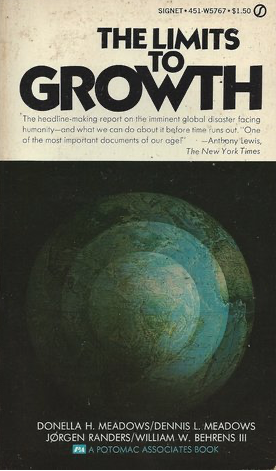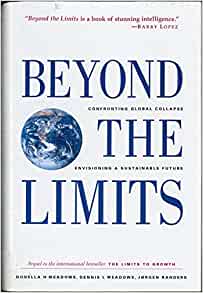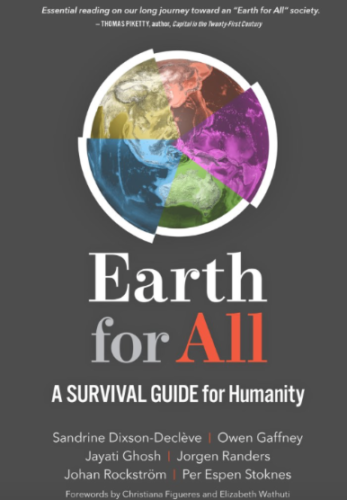The main fears of the Club of Rome’s 1972 study have been reaffirmed, the authors say. But there is still a scenario allowing for widespread increases in human wellbeing within the planet’s resource boundaries.

Preparing posters and signs for U.N. Conference on the Human Environment in Stockholm, June 5-16, 1972. (U.N. Photo/Yutaka Nagata)
By Hezri A Adnan and Jomo Kwame Sundaram
in Kuala Lumpur
Inter Press Service

 Ahead of the first United Nations environmental summit in Stockholm in 1972, a group of scientists prepared The Limits to Growth report for the Club of Rome. It showed planet Earth’s finite natural resources cannot support ever-growing human consumption.
Ahead of the first United Nations environmental summit in Stockholm in 1972, a group of scientists prepared The Limits to Growth report for the Club of Rome. It showed planet Earth’s finite natural resources cannot support ever-growing human consumption.
Limits used integrated computer modeling to investigate 12 planetary scenarios of economic growth and their long-term consequences for the environment and natural resources.
Emphasizing material limits to growth, it triggered a major debate. Authored by Donella H. Meadows, Dennis L. Meadows, Jørgen Randers and William W. Behrens III, Limits is arguably even more influential today.
Within Limits
Limits considered population, food production, industrialization, pollution and non-renewable resource use trends from 1900 to 2100.
It conceded, “Any human activity that does not require a large flow of irreplaceable resources or produce severe environmental degradation might continue to grow indefinitely.”
Most projected scenarios saw growth ending this century. Ominously, Limits warned of likely ecological and societal collapses if anthropocene challenges are not adequately addressed soon enough.
Failure would mean less food and energy supplies, more pollution and lower living standards, even triggering population collapses.
But Limits was never meant to be a definitive forecast, and should not be judged as such. Instead, it sought to highlight major resource threats due to growing human consumption.
Off-Limits?
 Gaya Herrington, director of sustainability services at the auditing firm KPMG, has shown that three of Limits’ four major scenarios anticipated what is now trending. Two lead to major collapses by mid-century. She concluded, “humanity is on a path to having limits to growth imposed on itself rather than consciously choosing its own.”
Gaya Herrington, director of sustainability services at the auditing firm KPMG, has shown that three of Limits’ four major scenarios anticipated what is now trending. Two lead to major collapses by mid-century. She concluded, “humanity is on a path to having limits to growth imposed on itself rather than consciously choosing its own.”
Limits stressed the urgent need for radical transformation to achieve “sustainable development.” The “international community” embraced this, in principle, at the 1992 Earth Summit in Rio de Janeiro, two decades after Stockholm.
With accelerating resource depletion – as current demographic, industrial, pollution and food trends continue – the planet’s growth limits will be reached within the next half-century. The Earth’s “carrying capacity” is unavoidably shrinking.
Limits declared that only a “transition from growth to…a desirable, sustainable state of global equilibrium” can save the environment and humanity.
The report maintained it was still possible to create conditions for a much more sustainable future while meeting everyone’s basic material needs. As Gandhi said, “The world has enough for everyone’s need, but not enough for everyone’s greed.”
No other environmental work then, or since, has so directly challenged mainstream growth beliefs. Unsurprisingly, it attracted strong opposition.
The 1972 study was long dismissed by many as neo-Malthusian prophecy of doom, underestimating the potential for human adaptation through technological progress.
Many other criticisms have been made. Limits was faulted for focusing too much on resource limits, but not enough on environmental damage. Economists have criticized it for not explicitly incorporating either prices or socioeconomic dynamics.
Beyond Limits
 In Beyond the Limits (1993), the two Meadows and Randers argued that resource use had exceeded the world environment’s carrying capacity.
In Beyond the Limits (1993), the two Meadows and Randers argued that resource use had exceeded the world environment’s carrying capacity.
Using climate change data, they highlighted the likelihood of collapse, going well beyond the earlier focus on the rapid carbon dioxide build-up in the atmosphere.
In another sequel, Limits to Growth: The 30-Year Update (2004), they elaborated their original argument with new data, calling for stronger actions to avoid unsustainable excess.
Dennis Meadows stresses other studies confirm and elaborate Limits’ concerns. Various growth trends peak around 2020, suggesting likely slowdowns thereafter, culminating in environmental and economic collapse by mid-century.
Limits’ early 1970s’ computer modeling has been overtaken by enhanced simulation capabilities. Many earlier recommendations need revision, but the main fears have been reaffirmed.
Limitless?
Two key Limits’ arguments deserve reiteration. First, its critique of technological hubris, which has deterred more serious concern about the threats, thus undermining environmental, economic and other mitigation efforts.
As Limits argued, environmental crisis and collapse are due to socioeconomic, technological and environmental transformations for wealth accumulation, now threatening Earth’s resources and ecology.
Conventional profit-prioritizing systems and technologies have changed, e.g., with resource efficiency innovation. Such efforts help postpone the inevitable, but cannot extend the planet’s natural limits.
Of course, innovative new technologies are needed to address old and new problems. But these have to be deployed to enhance sustainability, rather than profit.
The Limits’ critique is ultimately of “growth” in contemporary society. It goes much further than recent debates over measuring growth, recognizing greater output typically involves more resource use.
While not necessarily increasing exponentially, growth cannot be unlimited, due to its inherent resource and ecological requirements, even with materials-saving innovations.
This Earth for All
 Thankfully, Limits’ fourth scenario – involving significant, but realistic transformations – allows widespread increases in human wellbeing within the planet’s resources.
Thankfully, Limits’ fourth scenario – involving significant, but realistic transformations – allows widespread increases in human wellbeing within the planet’s resources.
This scenario has inspired Earth for All – the Club of Rome’s Transformational Economics Commission’s 2022 report – which more than updates Limits after half a century.
Its subtitle – “A Survival Guide for Humanity” – emphasizes the threat’s urgency, scale and scope.
It argues that ensuring the wellbeing of all is still possible, but requires urgent fundamental changes. Major efforts are needed to eradicate poverty, reduce inequality, empower women and transform food and energy systems.
[Related: It Doesn’t Trickle Down]
The comprehensive report proposes specific strategies. All five need significant investments, including much public spending. This requires more progressive taxation, especially of wealth. Curbing wasteful consumption is also necessary.
More liquidity – e.g., via “monetary financing” and International Monetary Fund issue of more special drawing rights — and addressing government debt burdens can ensure more policy and fiscal space for developing country governments.
Many food systems are broken. They currently involve unhealthy and unsustainable production and consumption, generating much waste. All this must be reformed accordingly.
Market regulation for the public good is crucial. Better regulation – of markets for goods (especially food) and services, even technology, finance, labour and land – is necessary to better conserve the environment.
Limited Choice
The report includes a modeling exercise for two scenarios. “Too Little Too Late” is the current trajectory, offering too few needed changes.
With growing inequalities, social trust erodes, as people and countries compete more intensely for resources. Without sufficient “collective action,” planetary boundaries will be crossed. For the most vulnerable, prospects are grim.
In the second “Giant Leap” scenario, the five needed shifts are achieved, improving wellbeing all around. Everybody can live with dignity, health and security. Ecological deterioration is sufficiently reversed, as institutions serve the common good and ensure justice for all.
Broad-based sustainable gains in wellbeing need pro-active governance reshaping societies and markets. This needs sufficient political will and popular pressure for needed reforms.
But as the world moves ever closer to many limits, the scenario looming is terrifying: ecosystem destruction, gross inequalities and vulnerabilities, and social and political tensions.
While regimes tend to bend to public pressure, if only to survive, existing discourses and mobilization are not conducive to generating the popular political demands needed for the changes.
Jomo Kwame Sundaram, a former economics professor, was United Nations assistant secretary-general for economic development and received the Wassily Leontief Prize for Advancing the Frontiers of Economic Thought.
Adnan A Hezri is an environmental policy analyst and fellow of the Academy of Sciences, Malaysia. He is author of The Sustainability Shift: Reshaping Malaysia’s Future.
This article is from Inter Press Service.
The views expressed are solely those of the authors and may or may not reflect those of Consortium News.

Not one bit of the current global economic structure which depends on the silliest notions of perpetual “growth” and the mercantilist fantasy that identity is essential to life and living is conducive to sustaining the species overall. Government run by “ordinary” people would solve nothing since the ordinary person is as much a product of this foolishness as the billionaire who benefits the most from it. There is no one available externally that can willfully mend/cure the system; it is just not possible.
By pointing satellites at the Earth the amount of arable land can be measured and the carrying capacity of the Earth can be calculated. Based on how much land is required to grow food for one human being over an average lifetime, and how much land is required to produce all of the ‘stuff’ that a human being needs during his/her life (clothing, shelter, and all other material goods), it was found that the Earth could sustainably support about 530 million people without causing more environmental damage. This figure already took into account the environmental damage that had already occurred. An Earth without any environmental damage could support 1.5 billion people. One square kilometre of fertile land is able to feed twelve human beings over the course of an average human lifespan along with supporting all fauna and flora that also exists within such an area of land, in a sustainable way, in balance with nature. The amount of land and raw materials required for all of mankind’s other material ‘stuff’ is significantly more. As of 2021, the Earth can NATURALLY sustain far less than 530 million people. As the population increases, the Earth can support ever fewer people.
The greatest contribution to climate and environmental destruction lies in the agricultural industries, which must supply an ever increasing amount of food for the mass of humanity from an ever decreasing supply of suitable land. The harvesting and processing of the food by countless machines, the transport of foods to all areas of the globe by countless vehicles of all sizes and the manufacture of packaging, results in ever increasing pollution of the air, land and water bodies. … … …
Several commenters named the problem: capitalism. Strangely, no one named the solution: socialism
In my opinion,as I argued a few days ago(not here), the planet is a natural being and in order to save ourselves,we need more of natural solutions to fight climate change and less technologies.We need to restore our badly damaged environment i.e restore wetlands,afforestation as well as maintain what we already have. And,this needs to be done urgently. Unfortunately,those who claim to be advocating for solutions are focusing,in my opinion,on the wrong methods like, development of new technologies which,only add nothing but prolong the problem. If only they could focus on what is at than inventions which only exercebate the already serious crisis. NOTE: Let’s focus more on natural solutions than new technologies.
“But as the world moves ever closer to many limits, the scenario looming is terrifying: ecosystem destruction, gross inequalities and vulnerabilities, and social and political tensions. ”
This is a capitalism problem.
It is as if a large number of people have not figured out that the things they like, their habits and lifestyle routines, are not fundamental to life, but circumstantial in this particular socioeconomic context. There are others. We made this situation up.
With reasonable planning and a significant attitude change, and of course the abolition of the bourgeoisie dictatorship, and their pathological profiteering “identities”, we humans could easily manage our consumption needs and regenerate the ecological systems all life depends upon as well.
The problem is capitalism. Everything is done for profit, and if there is no private profit in change, there will be no change. That’s the great big trap. Capitalism is not just an economic system it is a social and cultural cage.
This is not rocket-surgery.
This system would rather bail out a failed idea (eg: private banking) with public funds than let a failed idea die off, because that would harm members of the “big club”. This system would rather kill millions or even billions while lying to the world, than admit it is unsustainable. The people who have the most wealth will only allow changes which maintain their massive wealth as a precondition for any plan to address global problems.
This is the problem.
The people who benefit most from this system of private profiteering, are unable to comprehend the notion that they are not the superior beings, but merely cognitively cornered into a narrow and obtuse hubris.
The very limited people in charge of this global structure cannot conceive of the notion that the only way the world can be saved, is if they no longer do things for private profit, but for mutual benefit.
It is as if I just told the plutocrats their god is dead, and their identity is nonsense: It just does not compute for them. Human, universal empathy, does not compute for them.
It is as if they are the owners of the main information dissemination systems of the globe, and even though some people awaken sometimes, they’re deliberately prevented from reaching a critical numerical mass which could actually threaten the plutocratic parasites.
The plutocrat parasites are killing the host, and the host is taught to blame itself.
I couldn’t agree more with most of your comment and also those of the others here. Capitalism in the form in which most of the top 1 to 2 % have MASTERbated it all these past decades is certainly bad. Still, we should not in frustration reject capitalism entirely. Doing so would be like throwing the baby out along with the bath water; totally foolish. We therefore have to save positive capitalism from the top exploitative crooks and cleanse and adopt socially-responsible and responsive capitalism and channel its blessings to uplift ENTIRE humanity. As God Almighty intends it, Humans have a status higher than animals, just don’t allow the rabid capitalist crooks to treat their dogs far better than the suppressed, oppresed and victimized humans in their neighborhoods and societies especially with the full COMPLICITY of the pigs and swines passing of themselves as their national political leaders !
it is capitalist pursuit of private profit first and public good – if at all – second which must radically change to a system of global democracy which places all humanity before, not after- individual human progress…ending capitalism will not solve all of humanity’s problems but it will end most of them, like war, poverty, environmental waste and destruction and other dreadfully unpleasant things for more than 98% of humanity.
The trouble is that it is the capitalists that are running the show. So, I don’t see them undermining the system that allows them to gather obscene amounts of wealth through the oppression of the masses and the destruction of the planet.
Maybe if there was some way of ensuring government was run by ‘ordinary people’ rather than millionaires and billionaires the outlook might be different. Government by the People, for the People ? No, it would never catch on …
What greater limit to growth could there possibly be than an economic system that destroys a third of the food produced every year, rather than have people consume it, merely to protect prices?